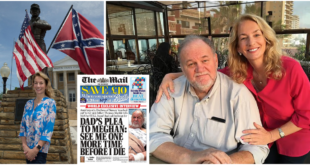Pope Emeritus Benedict XVI’s body is lying in state in St Peter’s Basilica as thousands of people file by to pay tribute to the pontiff who shocked the world by retiring a decade ago.
As daylight broke, 10 white-gloved Papal Gentlemen — lay assistants to pontiffs and papal households — carried the body on a cloth-covered wooden stretcher up the centre aisle of the basilica to its resting place in front of the main altar under Bernini’s towering bronze canopy.
A Swiss Guard saluted as the body was brought in through a side door after Benedict’s remains had been transferred from the chapel of the monastery grounds where the frail 95-year-old former pontiff died on Saturday morning.
The German cleric’s longtime secretary, Archbishop Georg Gaenswein, and a handful of consecrated laywomen who served in Benedict’s household, followed the van by foot in a silent procession towards the basilica.
Just after 9am, the doors of the basilica were swung open so the public, some of whom had waited for hours in the dampness before dawn, could pay their respects to the late pontiff, who in 2013 became the first pope to retire from the papacy in 600 years.
By mid-morning the queue to enter the basilica snaked around St Peter’s Square.
A few VIPs had a moment before the general public to pay their respects, including Italian premier Giorgia Meloni, the far-right leader who in the past has professed admiration for the conservative leanings of Benedict. Also viewing the body was President Sergio Mattarella.
The Vatican said only two nations – Italy and Germany – had official delegations with formal invites to the funeral, as Benedict was no longer head of state.

Filippo Tuccio, 35, arrived from Venice on an overnight train to view Benedict’s body.
“I wanted to pay homage to Benedict because he had a key role in my life and my education. I arrived here at around 7.30am, after leaving Venice last night,” he said.
“When I was young I participated in World Youth Days,” he added, referring to the jamborees of young faithful held periodically and attended by pontiffs.
Mr Tuccio added that he had studied theology and “his pontificate accompanied me during my university years”.
“He was very important for me, for what I am, my way of thinking, my values. This is why I wanted to say goodbye today.”
Public viewing lasts for 10 hours on Monday in St Peter’s Basilica. Twelve hours of viewing are scheduled for Tuesday and Wednesday before Thursday morning’s funeral, which will be led by Pope Francis at St Peter’s Square.

Security officials expect at least 25,000 people to pass by the body on the first day of viewing.
Marina Ferrante, 62, from Rome, arrived an hour before the doors were opened, and grew emotional when she explained why she came.
“I think his main legacy was teaching us how to be free,” she said. “He had a special intelligence in saying what was essential in his faith and that was contagious.
“The thing I thought when he died was that I would like to be as free as he was.
“I believe there’s a continuity between him and Pope Francis and whoever understands the real relationship between them and Christ can see that.”
Among those coming to the basilica viewing was Cardinal Walter Kasper, like Benedict, a German theologian. Cardinal Kasper served as head of the Vatican’s Christian unity office during Benedict’s papacy.
Benedict left an “important mark” on theology and spirituality, but also on the history of the papacy with his courage to step aside, he said.
“This resignation wasn’t a sign of weakness but a sign of strength, a greatness because he saw that he was no longer up to the challenges of being pope,” Cardinal Kasper said.
Kasper, who was among the cardinals who elected Benedict to the papacy in 2005, added that the resignation decision gave “a more human vision to the papacy: that the pope is a man and is dependent on his physical and mental strengths”.



